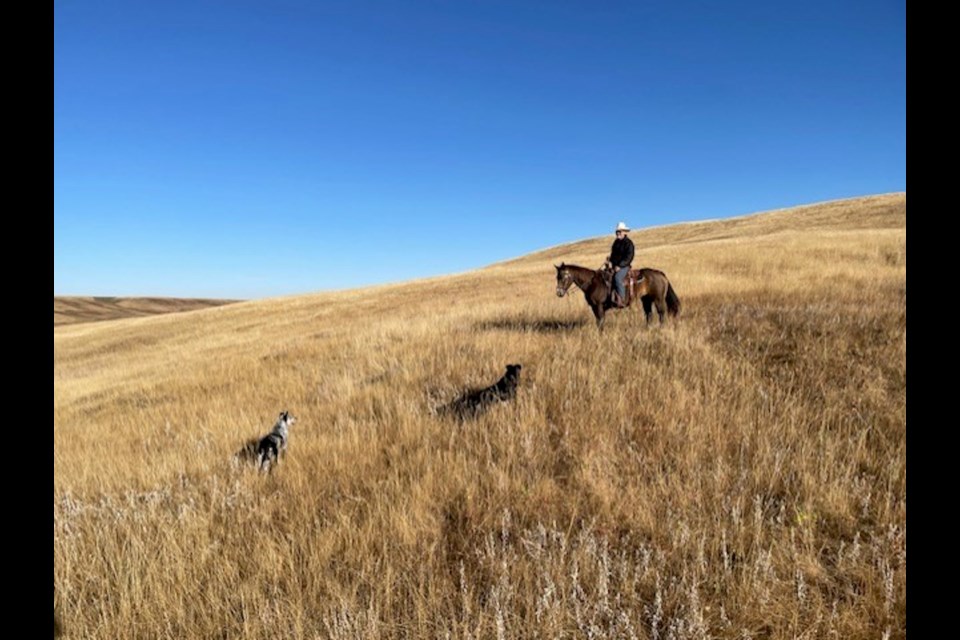Drought and water shortages have plagued the province over the last three years and farmers in Rocky View County are feeling the pressure.
Earl Munro, a cattle rancher in the Yankee Valley area, said livestock numbers in the area have dropped to about half of what they were three or four years ago as ranchers are forced to sell off heifers to match the feed that is available.
“The short term [effects] are obviously either adjusting our cattle units to the amount that's growing and then getting through to the next growing season,” Munroe said.
“The longer term [effects] as we graze our pastures heavier than we want, we tend to get bare spots and weeds in them. And you're losing carbon out of the soil and moisture holding capacity of the soil as you're not building up that organic matter that we hope to be doing.”
The Long Acre Ranch, which Munro owns together with his wife Tracy Hanson, doesn’t buy much feed for its animals and relies on their own feed production.
Last year they had to convert a small piece of grain land previously used to sell crops into land producing cattle feed.
While the ranch itself has been through tough times, Munro said this level of drought is a first for him and his wife since they took over from Hanson’s parents in 2000.
“We had 19 months in there that were dry in the early 2000s but never quite as long as this, or as dry,” Munro said.
While some of the financial stress is alleviated by his wife working off the farm, he said the challenges they’re facing can be draining.
There are days he wants to talk to his children more seriously about coming back to the farm, he said, because he’s unsure he wants to go through another season like last year.
“There are days, when it's 30 above and cooking, when it's hard to be motivated to want to deal with the cattle, because [every time] you go they're going downhill rather than growing,” he said.
“On some level, I feel like we're better off with the stress because we don't have a lot of money [invested] going into the year except for the land, [unlike] crop lands.”
He said crop farmers invest large capital up front ahead of the growing season.
“We have very little cash up front cost into the year, so it's more [about] managing the cattle numbers,” he said. “We've been lucky with the calf prices. As Alberta's numbers have gone down because of the drought, the calf prices have gone up.”
As a result, their revenue has fallen by about 25 per cent while their cattle numbers fell by half, he said.
Still, Munro has no interest in growing their herd any time soon since their pastures have already been grazed more than he would have liked for the last two years.
He plans to apply for the drought relief program in Rocky View County this year.
“As we plan for 2024, we have 160 acres of irrigation and in 2023 we sort of got cut back twice,” Munro said. “We wanted to start irrigating and they didn't have the water supply.”
He said that was the first time he or his father-in-law, who previously ran the ranch, experienced not being allowed to irrigate.
“By 2024, they're already talking about being limited because the Bow River has less flow,” he said, adding that water consumption first goes to human use, pushing agriculture use to the back. “We're anticipating that we're going to have some restrictions on the ability to grow deeper for the winter of 2024.”
Water remains the biggest challenge for most farmers.
Munro said they went from hauling water across their pastures due to empty dugouts to putting in two and a half miles of pipe to supply water more efficiently. He’s still hauling water to other pastures for a total of 120 days last year.
“We all have bad days of work,” he said, adding the drought struggle gets old.
“And it gets old complaining to people about it too, because people enjoy the sunshine too ... But when they're talking about water restrictions in Calgary at the end of December, [that means] they're short.”
Munro hopes the predictions for 2024 don’t come true, but said they will get through it.
“With El Niño bringing warmer winter temperatures and less precipitation, we know this brings the potential for continued drought conditions this upcoming growing season,” said Alberta’s minister of agriculture and irrigation RJ Sigurdson in a letter released earlier this month.
As a result, Alberta’s government promised to help the agriculture and agri-food industries through expanding and improving irrigation systems with $399 million invested.
Sigurdson encouraged all Albertans to conserve water.
“Know that the water you might use to water your lawn could be used downstream to grow the crops that produce your food,” he said.
The 2023 Canada-Alberta Drought Livestock Assistance initiative recently expanded eligibility to 23 new regions as well as extended the application deadline to Jan. 29.
Additionally, the province provides AgKnow, the Alberta Farm Mental Health Network, connecting farmers and their families to local service providers and resources designed for the agriculture industry.



